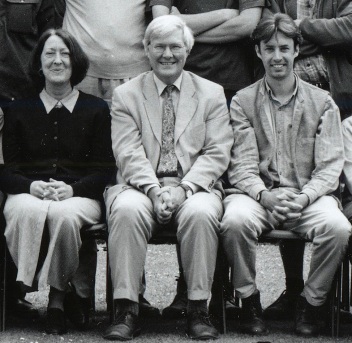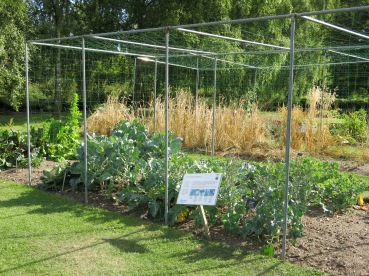Director of Cambridge University Botanic Garden 1996 – 2010
Professor of Plant Cytogenetics, University of Cambridge
Acting Curator, then Curator of the University Herbarium, 1999 – 2010
Fellow of St Catharine’s 1997 – 2006 and Clare Hall 2007 – present, Cambridge
Education & Career
D.Phil, Christ Church, Oxford, Plant chromosomes and natural populations 1971
Lecturer and Reader in Genetics, Queen Mary College, University of London 1969 – 1992
Lecturer in Botany, University of Reading
Head of Department of Botany, University of Reading 1992 – 1996
 (From left) John Parker, Tim Upson, Peter Kerley and Sally Petitt, 2001
(From left) John Parker, Tim Upson, Peter Kerley and Sally Petitt, 2001
Raising the Profile Professor John Parker joined the Botanic Garden in 1996 following the publication of the Board’s Report of the five-year Review of the Botanic Garden in 1995. The Report gave the incoming Director the remit to forge stronger links with Cambridge University Departments. John Parker said: ‘One had to show that the university was benefitting from having a Botanic Garden in the way it was. And it had to be explicitly demonstrated. So one of the things I had to do was to go around and tell [university colleagues] what we could offer them as part of their academic work, whether it was part of their research or teaching… It was raising the profile, [showing] that the university had an asset which could be exploited… It was important that I left the Garden in a way that the University would understand that it had a jewel in its crown, not a millstone around its neck.’
Public Engagement
In addition to raising the profile of the Garden’s facilities and amenities within the University, John Parker began programmes of public engagement with the local community and beyond. These included developing a Schools education programme, introducing more detailed colour-printed annual reports with articles about the workings of the Garden, Courses for adults, Trails, a weekly column in the Cambridge Evening News, a Website and the growth of the Friends of the Botanic Garden. He employed an Education Officer – increasing eventually to three – and a Development Officer. He took the opportunity to give public lectures to numerous local Societies and community groups, and professionalized the horticultural training in the Garden with the introduction of the first University qualification with a work-based component. Science and Plants for Schools, located in the Botanic Garden from 2010. Read more about John Parker’s Education and Public Engagement initiatives in 1990s Sustainability for Survival.
The Genetics Garden Plant breeding and plant hybridisation has a history that goes back to the first farmers, over 10,000 years ago, selecting the best seeds for forthcoming crops. The Genetics Garden was developed in 1998 by John Parker with seeds supplied by the John Innes Institute and the National Institute of Agricultural Botany (NIAB). The Genetics Garden was created to demonstrate ‘the dramatic effect of genes on plant growth and development and how, over the years, plant breeders have improved the crops we grow.’
Genetics and the development of hybridisation has a long history at Cambridge. Indeed it was Cambridge zoologist William Bateson, who coined the term ‘genetics’. Bateson and his botanist colleague Edith Saunders carried out the first genetic experiments in Britain on experimental plots in the allotments at the eastern end of the Botanic Garden in the late-nineteenth and early-twentieth century. The Genetics demonstration beds show the developmental control of pea leaves, the effects of dwarfing genes in wheat, the control of floral development, derivatives from wild cabbage Brassica oleracea and from wild sea beet Beta maritima.

 International legal controversies over the use of genetically-modified crops lead to the topic of genetics and genetic-modification to be hotly debated in the media.
International legal controversies over the use of genetically-modified crops lead to the topic of genetics and genetic-modification to be hotly debated in the media.
The Sainsbury Laboratory The development of the £82m Sainsbury Laboratory for Plant Development in the private area of the Botanic Garden was a massive development project during the final period of John Parker’s directorship. He was the University Representative User and signed off the building on behalf of the University. This high-profile science laboratory further increased the profile of the Botanic Garden and research into plant sciences in Cambridge, as well as providing a new home for the University Herbarium. The project also enabled the development and renovation of both private and public areas of the Botanic Garden, including the contraction of a new entrance and ticket office on Trumpington Road and the first purpose-built education suite in the Garden’s history. (Above right) Professor John Parker in conversation with Prince Philip at the opening of The Sainsbury Laboratory in 2011.

Apple Day is a popular annual event, which was first introduced into the Botanic Garden’s calendar by John Parker (also a Trustee of the National Fruit Collection) in November 1997.
Interests 1. John Stevens Henslow, founder of the new Cambridge University Botanic Garden, the development of Cambridge science and Henslow’s influence on shaping Darwin’s intellectual development. In 2009, an exhibition was held at the Botanic Garden, in Brookside on Henslow’s influence on Darwin. 2. Chromosomes in natural populations of flowering plants.
 John Parker (centre) in 2006, with the Mayor of Cambridge (left) and the Chairman of the Blue Plaque Association (right) at the dedication of the blue plaque naming John Stevens Henslow as the founder of the ‘new’ Botanic Garden in the nineteenth century. The blue plaque can now be seen on No 1 Brookside outside the entrance to the Botanic Garden shop.
John Parker (centre) in 2006, with the Mayor of Cambridge (left) and the Chairman of the Blue Plaque Association (right) at the dedication of the blue plaque naming John Stevens Henslow as the founder of the ‘new’ Botanic Garden in the nineteenth century. The blue plaque can now be seen on No 1 Brookside outside the entrance to the Botanic Garden shop.
Garden Voices Listen to John Parker talking about the connection between the Botanic Garden, Henslow, Darwin and the development of The Sainsbury Laboratory.
| Selected List of Publications – Professor John Parker |










